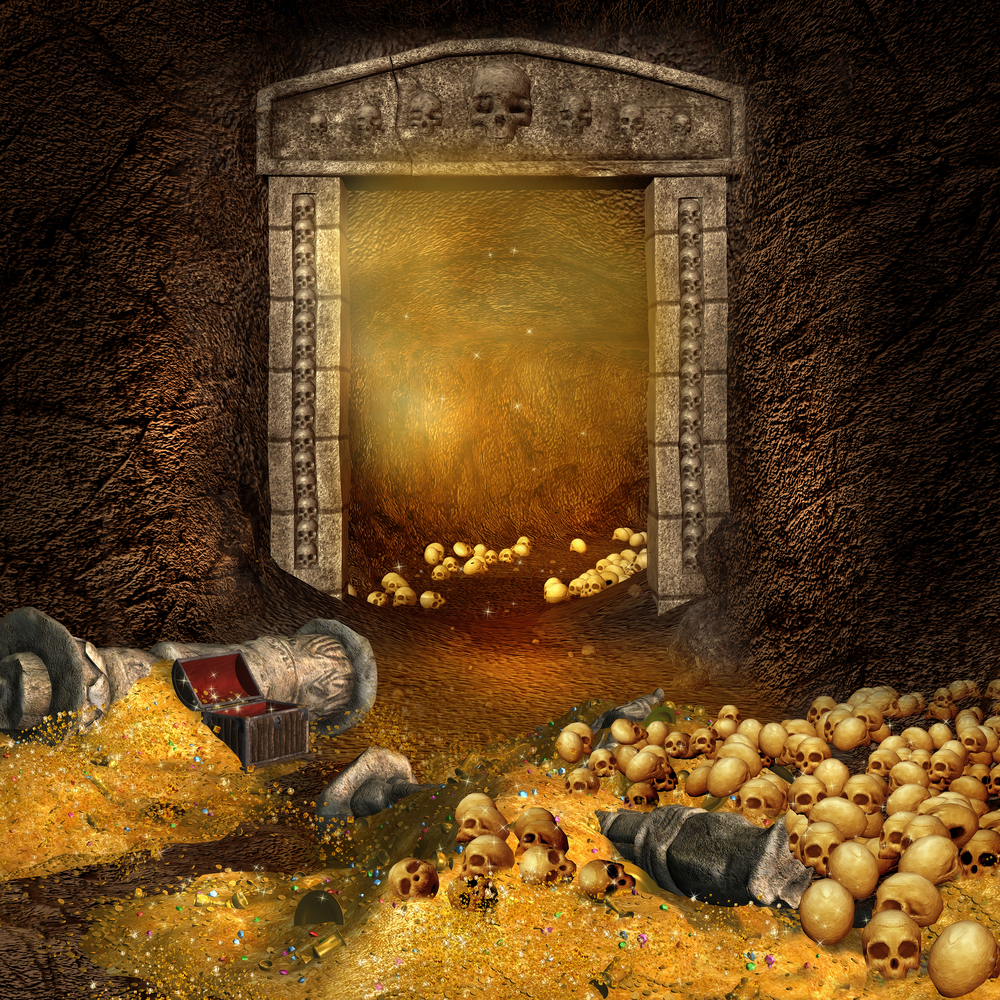Encumbrance. What a dirty word right? In Dungeons and Dragons it is kind of an important point to consider. We all know that our players want to raid the dungeon and haul away the goodies. They want to leave nothing behind. But if you look at the picture above you have to think to yourself. How exactly would a bunch of armored folks in an underground catacomb manage to get all this stuff out of the dungeon and safely to town? There is a ton of treasure in that picture. And gold is heavy right?
Encumbrance is even more important in the early editions of the game where experience was gained on a basis of one point for one gold piece taken. The early editions of the game had a bit of a different feel to them than the later editions. This is because the game was more about successfully taking treasure out of the dungeon than it was about killing things. If one could raid the dungeon and steal all of the gold without ever fighting anything at all they would still gain a whole lot of experience and take fewer risks.
The game has evolved over the years because the developers discovered what most Dungeon Masters already knew. Their players enjoy killing things. They often prefer to kill things and then take the treasure even if they could obtain it without combat.
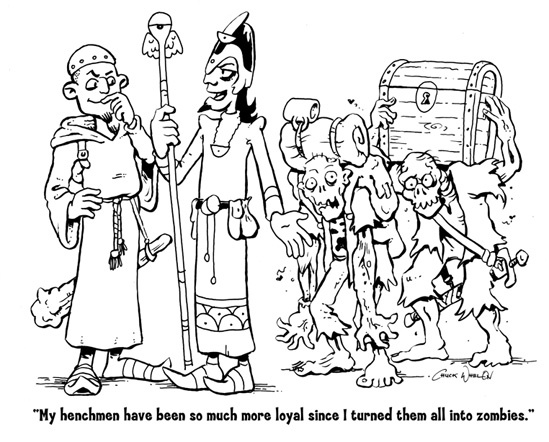
Encumbrance in Dungeons and Dragons Original Edition
Page 15 of Men and Magic is the first place in which encumbrance is discussed. A short list of items and their weights is provided. Then movement rates for different levels of encumbrance is offered. If you are carrying 1500 gold pieces in weight then you can move at 6′. If you are carrying 1000 gold pieces in weight then you can move 9′ And if you are carrying 750 gold pieces in weight then you can move up to 12′. The maximum a man could carry would be 3000 gold pieces. Presumably after this amount of weight the person could no longer move at all. At 3000 gold pieces of weight the person could only move at half the normal rate.
Notice a couple of things about these rules. Strength is not a consideration in Original Dungeons and Dragons. That came into play with 1st edition. Coins all weigh the same. Copper, silver platinum and gold are all treated as “coins” for purposes of weight. Weight is given in terms of a specific number of coins in weight. This is for obvious reasons of course. If experience is being given on a basis of one gold piece per one point of experience then we are only interested in how many gold pieces (worth) of treasure that the adventurers can extract from the dungeon.
The one gold piece equals one experience point is discussed on page 18 of Men and Magic. There is a discussion there about, perhaps, offering less than a one gold piece per one experience point in the situations where the characters take the treasure from monsters that are not particularly challenging to the adventurers.
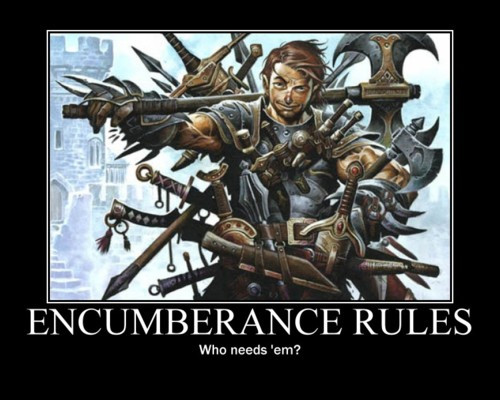
Encumbrance in Dungeons and Dragons 1st and 2nd Editions
In First Edition Encumbrance is discussed in several places. On page 101 of the Player’s Handbook the subject is again discussed in terms of movement rate. But it also adds the elements of reaction and initiative. Instead of coins it discussed weight in terms of pounds. One carrying normal gear (under 35 pounds) would move at 12″. One wearing heavy gear or carrying heavy weight (up to 70 pounds) would move at 9″ but would gain no initiative or reaction bonuses. One carrying very heavy gear (up to 105 pounds) would move at 6″ and would have slowed reactions and initiative. Very heavy gear includes anyone wearing plate armor. And one heavily encumbered (over 105 pounds) would move at a maximum of 3 to 4″ and would be greatly slowed in reaction and initiative.
For purposes of 1st Edition 10 gold pieces equals one pound. Strength bonuses apply to these movement rates (and reaction times). Naturally this means one needs to look at the strength table on page 9. This table gives weight allowances (bonuses) due to strength. These bonuses are used for determining how much or how much less that a person can carry and still qualify for the different movement rates above. For example a person with 18/00 strength can carry an additional 3000 coins worth of weight. Notice how this table goes back to using coins again as weight measurement?
Page 225 of the Dungeon Master Guide provides a slightly longer list of items and their normal encumbrances. But this list is hardly comprehensive. After all there are many different types of treasure to be found in a dungeon. How much does a statue weigh? What if it is made of gold? Marble? Platinum? How much does a framed painting weigh? Or a bolt of silk? None of these are answered. The dungeon master is left to determine these things on their own.
Now for Second Edition is important to note that the one gold piece per one experience point rule was now no longer mandatory. It was an optional rule. This might well come into play in determining just how much a Dungeon Master wanted to keep track of this. If we no longer care how much treasure they are taking (in terms of experience) then it no longer seems quite as important. This optional rule is discussed on page 69 of the Dungeon Master Guide (Revised).
Page 76 of the Player’s Handbook for Second Edition presents Encumbrance as an optional rule. Presumably this is because without the experience for treasure rules it no longer mattered that much. But for sake of reality some dungeon masters might not want players reaching into their backpacks and pulling out another set of armor when the rust monster eats their plate mail. Or to prevent some similar occurrence.
Encumbrance in the Second Edition optional rule is set up strictly by a strength table. If you are this strong and are carrying this much then you are this encumbered. And movement is affected accordingly.
This edition also offered two other optional rules for encumbrance. One is for tournament play. And the other is a slightly more fine tuned version of the rule called the “Special Encumbrance Rule.” All of these rules are optional in Second Edition. This edition also discussed rules for encumbrance of pack animals.
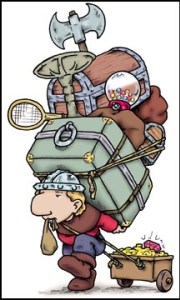
Encumbrance in Dungeons and Dragons 5th Edition
Encumbrance in Fifth Edition is simplified a bit. Your carrying capacity is equal to your strength score multiplied by 15. This is the number of total pounds that you can carry. This is stated on page 176 of the Player’s Handbook.
There is a variant rule stated in the next paragraph regarding Encumbrance. This is for people who want more than the simple rule set out above. If you are more into realism then perhaps this rule will fit your needs. If you carry more than 5 times your strength score then you are encumbered. This drops your movement rate by 10 feet. If you carry more than 10 times your strength score then you are heavily encumbered and your movement rate drops by 20 feet and you have disadvantage on ability checks, attack rolls and saving throws that depend upon strength, dexterity or constitution. Still pretty simple isn’t it?
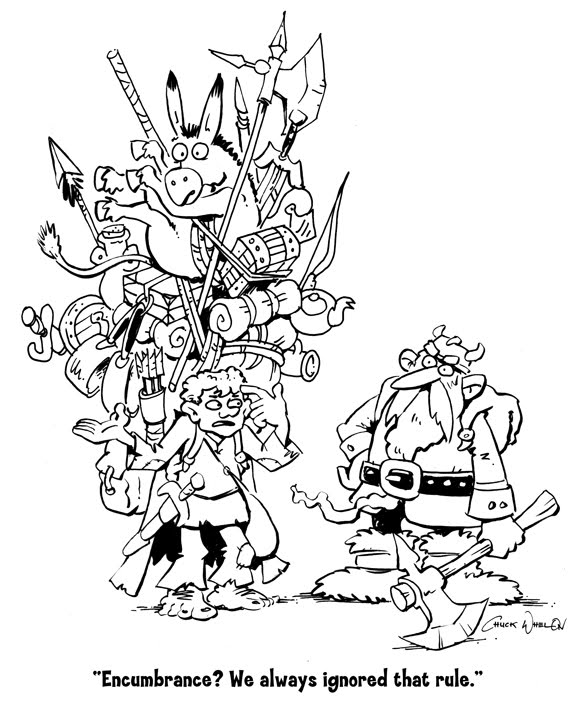
Why is encumbrance important in the early editions?
In the early editions if you are gaining an experience point for every gold piece (or equivalent value of treasure) then you are going to grab every piece of loot that you can. But if there are restrictions because of encumbrance then the players have to make choices. Do I carry out the statue of Bahamut made of copper or do I take the sack of 500 gold pieces? Which one do I leave behind? And that extra suit of plate mail I just found is getting left in the hallway because I cannot carry it and the golden bust of the king I found in the last room.
Ultimately if you are not keeping track of encumbrance in early editions and are using the 1 gold piece equals 1 experience point rule then the characters are going to level up much faster than they should be able to. They are just going to grab everything that they find and take it with them. And then sort out whether it is valuable or not. But if you are following the rules then the players have to make tough choices. Sometimes very tough choices. It is hard to part with that ancient mandolin that you just found. You do not know for sure that it is valuable but it might be extremely valuable. But if you have to choose between carrying it out of the dungeon or the 500 gold pieces in the sack you are probably going to choose the sack. After all….you know it is worth 500 gold pieces.
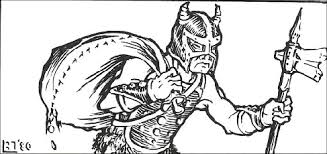
Why is encumbrance important in 5th edition?
It isn’t very important really. Not if you are hardly limited at all in terms of weight. If you are following just the primary rule then there are few drawbacks to carrying as much as you can. But those of you who play Fifth Edition already know that you tend to find quite a bit less treasure in this edition than in earlier ones. Money is no longer tied to experience gain. Encumbrance in daily play is something that rarely comes up. Sure…there may be creatures with treasure hoards. But the average creature is not carrying 5000 gold pieces in a sack.
But it is important if you consider some bit of realism to be important. Having people carrying five suits of back up armor and five back up weapons is kind of ridiculous. But it could easily happen if your player’s characters do not have to worry about Encumbrance.
To my mind at least the optional rule should be used. This would, at least, impose some sense of reality to the game.
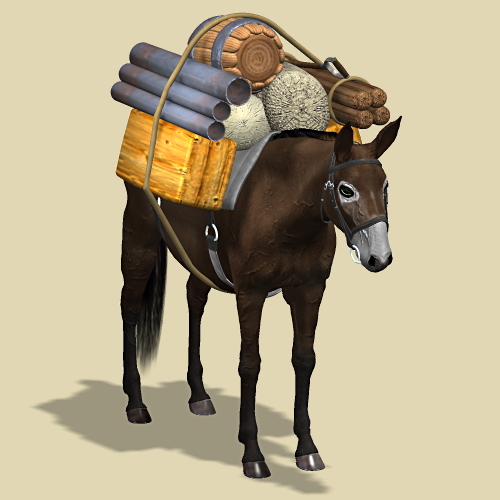
Is reality important in a fantasy game?
We are talking about a game in which people become heroes and travel to dungeons (or even other planes) to slay monsters and take their treasures. Is it really important to impose some reality rules like Encumbrance on the game? i leave that decision to you. Obviously you know your players better than I do. Do they care? Do you? If not then ignore the rules. Do what works for your own campaign.
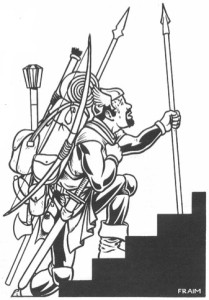
So how do I handle encumbrance in my own 1st Edition AD&D games?
For a very long time I just ignored the rules entirely. It never occurred to me how important that the rules can be.
But in recent years I began calculating what the party members could carry by virtue of their strength scores. I then added up the total amount of coins that the party could carry and still move at certain rates of speed. The players have a treasure sheet which they list what they are taking with them during an expedition. This list is made in terms of coins. I assign coin weight values to individual treasures that are not coins. The party can carry this amount without taking a movement rate and initiative penalty. If they want to carry more then they can….if they pay the price for it in slow speed and slow reactions.
Is this “By the Book?” Probably not. But it is workable. For me anyway. Of course characters ability scores can change. And group members die and get replaced. So I have to modify my numbers each time one of these things happens.
Does this change my games? Yes it does. Now the party leaves the copper and silver coins behind every time they take things out of the dungeon. They take the gold and the platinum and the gems and jewelry. They take the magic items that they find (or recognize as such). And when they find that solid gold statue that weighs 5000 pounds they have to figure out just how to get it out of the dungeon or they leave it behind. It slows things down. And that frustrates the players a little bit. But it also adds an element to the game that was missing. For now they have to worry about the logistics of taking large treasures out of a hostile environment. And that is not always an easy thing.
If you enjoyed this article then perhaps you will enjoy these as well:
- Caverns of Thracia Review
- The Maltese Clue Review
- Verbosh Review
- Lara’s Tower Review
- Restormel Review
- The Dragon Crown Review
- Escape From Astigar’s Lair Review
- Hall of the Fire Giant King Review
- Glacial Rift of the Frost Giant Jarl Review
- Steading of the Hill Giant Chief Review
- Tegel Manor Review
- F’Deck Fo’s Tomb Review
- Operation Ogre Review
- Inferno Review
